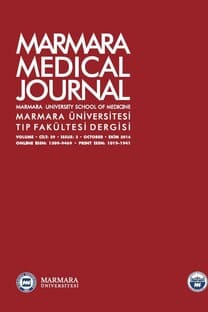Relationship between COVID-19 and antimicrobial resistance
Relationship between COVID-19 and antimicrobial resistance
Antimicrobial resistance, Bacterial infection, COVID-19, Fungal infection,
___
- World Health Organization. Coronavirus Disease 2019 (COVID-19) Situation Report – 51. https://www.who.int/docs/ default-source/coronaviruse/situation-reports/20200311 – sitrep-51-covid 19.pdf?sfvrsn=1ba62e57_10. [Accessed on 30 January 2022]
- Lai CC, Chen SY, Ko WC, Hsueh PR. Increased antimicrobial resistance during the COVID-19 pandemic. Int J Antimicrob Agents 2021; 57:106324. doi: 10.1016/j.ijantimicag.2021.106324.
- Rizvi SG, Ahammad SZ. COVID-19 and antimicrobial resistance: A cross-study. Sci Total Environ 2022; 807(Pt 2):150873. doi: 10.1016/j.scitotenv.2021.150873.
- Bengoechea JA, Bamford CG. SARS-CoV-2, bacterial coinfections, and AMR: the deadly trio in COVID-19? EMBO Mol Med 2020; 12:e12560. doi: 10.15252/emmm.202012560.
- Langford BJ, So M, Raybardhan S, et al. Bacterial co-infection and secondary infection in patients with COVID-19: a living rapid review and meta-analysis. Clin Microbiol Infect 2020; 26:1622-9. doi: 10.1016/j.cmi.2020.07.016.
- Clancy CJ, Nguyen MH. coronavirus disease 2019, superinfections, and antimicrobial development: What can we expect? Clin Infect Dis 2020; 71:2736-43. doi: 10.1093/cid/ ciaa524.
- Klinik örnekten sonuç raporuna uygulama rehberi. Solunum sistemi örnekleri. Klinik Mikrobiyoloji Uzmanlık Derneği Yayınları 2015; 44-55. Available from: https://www.klimud. org/public/uploads/files/solunumsistemi – ornekleri.pdf [Accessed on 17 February 2022]
- The European Committee on Antimicrobial Susceptibility Testing (EUCAST) 2020. http://www.eucast.org/clinical_ breakpoints/ [Accessed on 17 February 2022]
- Nori P, Cowman K, Chen V, et al. Bacterial and fungal coinfections in COVID-19 patients hospitalized during the New York City pandemic surge. Infect Control Hosp Epidemiol 2021; 42:84-8. doi: 10.1017/ice.2020.368.
- Zhu X, Ge Y, Wu T, et al. Co-infection with respiratory pathogens among COVID-2019 cases. Virus Res 2020; 285:198005. doi: 10.1016/j.virusres.2020.198005.
- [11] Zhou F, Yu T, Du R, et al. Clinical course and risk factors for mortality of adult inpatients with COVID-19 in Wuhan, China: a retrospective cohort study. Lancet 2020; 395(10229):1054- 62. doi: 10.1016/S0140-6736(20)30566-3.
- Rawson TM, Moore LSP, Zhu N, et al. Bacterial and Fungal Coinfection in Individuals With Coronavirus: A Rapid Review To Support COVID-19 Antimicrobial Prescribing. Clin Infect Dis 2020; 71:2459-68. doi: 10.1093/cid/ciaa530.
- Lansbury L, Lim B, Baskaran V, Lim WS. Co-infections in people with COVID-19: a systematic review and metaanalysis. J Infect 2020; 81(2):266-75. doi: 10.1016/j. jinf.2020.05.046.
- Huang C, Wang Y, Li X, et al. Clinical features of patients infected with 2019 novel coronavirus in Wuhan, China. Lancet 2020; 395(10223):497-506. doi: 10.1016/S0140- 6736(20)30183-5.
- Teich VD, Klajner S, Almeida FAS, et al. Epidemiologic and clinical features of patients with COVID-19 in Brazil. Einstein (Sao Paulo) 2020; 18:eAO6022. doi: 10.31744/einstein_ journal/2020ao6022.
- Gerver SM, Guy R, Wilson K, et al. National surveillance of bacterial and fungal coinfection and secondary infection in COVID-19 patients in England: lessons from the first wave. Clin Microbiol Infect 2021; 27:1658-65. doi: 10.1016/j. cmi.2021.05.040
- Silva DL, Lima CM, Magalhães VCR, et al. Fungal and bacterial coinfections increase mortality of severely ill COVID-19 patients. J Hosp Infect 2021; 113:145-54. doi: 10.1016/j. jhin.2021.04.001.
- Yang X, Yu Y, Xu J, et al. Clinical course and outcomes of critically ill patients with SARS-CoV-2 pneumonia in Wuhan, China: a single-centered, retrospective, observational study. Lancet Respir Med 2020; 8:475-81. doi: 10.1016/S2213- 2600(20)30079-5.
- Dong X, Cao YY, Lu XX, et al. Eleven faces of coronavirus disease 2019. Allergy 2020; 75:1699-709. doi: 10.1111/ all.14289. Chen X, Zhao B, Qu Y, et al. Detectable serum SARS-CoV-2 viral load (RNAaemia) is closely correlated with drastically elevated interleukin 6 (IL-6) level in critically ill COVID-19 patients. Clin Infect Dis 2020; 71:1937-42. doi: 10.1093/cid/ ciaa449.
- Zamora-Cintas MI, López DJ, Blanco AC, et al. Coinfections among hospitalized patients with covid-19 in the first pandemic wave. Diagn Microbiol Infect Dis 2021; 101:115416. doi: 10.1016/j.diagmicrobio.2021
- Antinori S, Galimberti L, Milazzo L, Ridolfo AL. Bacterial and fungal infections among patients with SARS-CoV-2 pneumonia. Infez Med 2020; 28(suppl 1):29-36.
- Chen N, Zhou M, Dong X, et al. Epidemiological and clinical characteristics of 99 cases of 2019 novel coronavirus pneumonia in Wuhan, China: a descriptive study. Lancet 2020; 395(10223):507-13. doi: 10.1016/S0140-6736(20)30211-7.
- Du Y, Tu L, Zhu P, et al. Clinical features of 85 fatal cases of COVID-19 from Wuhan: a retrospective observational study. Am J Respir Crit Care Med 2020; 201:1372-9. doi: 10.1164/ rccm.202.003.0543OC.
- Zavascki AP, Falci DR. Clinical Characteristics of Covid-19 in China. N Engl J Med 2020; 382(19):1859. doi: 10.1056/ NEJMc2005203.
- ISSN: 1019-1941
- Yayın Aralığı: 3
- Başlangıç: 1988
- Yayıncı: Marmara Üniversitesi
Congenital cytomegalovirus infection cases and follow-up findings in Antalya, Turkey
Zubeyde ERES SARITAS, Bilal Olcay PEKER, Dilek ÇOLAK, Imran SAGLIK, Rabia Can SARİNOĞLU, Murat TURHAN, Aslı BOSTANCI TOPTAŞ, Derya MUTLU, Gözde ÖNGÜT, Nihal OYGUR, Munire ERMAN
Relationship between COVID-19 and antimicrobial resistance
Tuba MÜDERRİS, Selcuk KAYA, Fulya BAYINDIR BİLMAN, Erkan OZMEN, Bilal Olcay PEKER, Ayşegül AKSOY GÖKMEN, Süreyya GÜL YURTSEVER
The relationship between smartphone and computer games and anger in adolescents
Wearable technology data-based sleep and chronic disease relationship
Hayati KART, Abdullah DEMIRTAS, Mehmet Esat UYGUR, Fuat AKPINAR
Monitoring tissue perfusion during extracorporeal circulation with laser speckle contrast imaging
Halim ULUGOL, Melis TOSUN, Ugur AKSU, Esin ERKEK, Pinar GUCLU, Murat OKTEN, Fevzi TORAMAN
Heart rate variability of acute ischemic stroke patients according to troponin levels
Cigdem ILERI, Zekeriya DOGAN, Ipek MIDI
Cholinergic cognitive enhancer effect of Salvia triloba L. essential oil inhalation in rats
Gulsah Beyza ERTOSUN, Mehmet ERGEN, Hilal BARDAKCI, Timur Hakan BARAK, Guldal SUYEN
